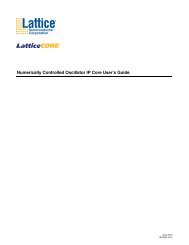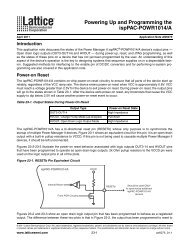DS1036 - Platform Manager Data Sheet - Lattice Semiconductor
DS1036 - Platform Manager Data Sheet - Lattice Semiconductor
DS1036 - Platform Manager Data Sheet - Lattice Semiconductor
Create successful ePaper yourself
Turn your PDF publications into a flip-book with our unique Google optimized e-Paper software.
72<br />
<strong>Platform</strong> <strong>Manager</strong> <strong>Data</strong> <strong>Sheet</strong><br />
The optional IDCODE (identification code) instruction is incorporated in the <strong>Platform</strong> <strong>Manager</strong> and leaves it in its<br />
functional mode when executed. It selects the Device Identification Register to be connected between PTDI and<br />
PTDO. The Identification Register is a 32-bit shift register containing information regarding the IC manufacturer,<br />
device type and version code (Figure 54). Access to the Identification Register is immediately available, via a TAP<br />
data scan operation, after power-up of the device, or by issuing a Test-Logic-Reset instruction. The bit code for this<br />
instruction is defined by <strong>Lattice</strong> as shown in Table 22.<br />
Figure 54. <strong>Platform</strong> <strong>Manager</strong> ID Code<br />
<strong>Platform</strong> <strong>Manager</strong> Specific Instructions<br />
MSB LSB<br />
0100 0000 0001 0100 0100 / 0000 0100 001 / 1<br />
0101 0000 0001 0100 0100 / 0000 0100 001 / 1<br />
Part Number<br />
(20 bits)<br />
40144h = LPTM10-1247-3<br />
50144h = LPTM10-12107-3<br />
JEDEC Manufacturer<br />
Identity Code for<br />
<strong>Lattice</strong> <strong>Semiconductor</strong><br />
(11 bits)<br />
Constant 1<br />
(1 bit)<br />
per 1149.1-1990<br />
There are 25 unique instructions specified by <strong>Lattice</strong> for the <strong>Platform</strong> <strong>Manager</strong>. These instructions are primarily<br />
used to interface to the various user registers and the E 2 CMOS non-volatile memory. Additional instructions are<br />
used to control or monitor other features of the device. A brief description of each unique instruction is provided in<br />
detail below, and the bit codes are found in Table 22.<br />
CPLD_ADDRESS_SHIFT – This instruction is used to set the address of the CPLD AND/ARCH arrays for subsequent<br />
program or read operations. This instruction also forces the outputs into the OUTPUTS_HIGHZ.<br />
CPLD_DATA_SHIFT – This instruction is used to shift CPLD data into the register prior to programming or reading.<br />
This instruction also forces the outputs into the OUTPUTS_HIGHZ.<br />
CPLD_INIT_ADDR_FOR_PROG_INCR – This instruction prepares the CPLD address register for subsequent<br />
CPLD_PROG_INCR or CPLD_VERIFY_INCR instructions.<br />
CPLD_PROG_INCR – This instruction programs the CPLD data register for the current address and increments<br />
the address register for the next set of data.<br />
CPLD_PROGRAM – This instruction programs the selected CPLD AND/ARCH array column. The specific column<br />
is preselected by using CPLD_ADDRESS_SHIFT instruction. The programming occurs at the second rising edge<br />
of the PTCK in Run-Test-Idle JTAG state. The device must already be in programming mode<br />
(PROGRAM_ENABLE instruction). This instruction also forces the outputs into the OUTPUTS_HIGHZ.<br />
PROGRAM_SECURITY – This instruction is used to program the electronic security fuse (ESF) bit. Programming<br />
the ESF bit protects proprietary designs from being read out. The programming occurs at the second rising edge of<br />
the PTCK in Run-Test-Idle JTAG state. The device must already be in programming mode (PROGRAM_ENABLE<br />
instruction). This instruction also forces the outputs into the OUTPUTS_HIGHZ.<br />
CPLD_VERIFY – This instruction is used to read the content of the selected CPLD AND/ARCH array column. This<br />
specific column is preselected by using CPLD_ADDRESS_SHIFT instruction. This instruction also forces the outputs<br />
into the OUTPUTS_HIGHZ.<br />
DISCHARGE – This instruction is used to discharge the internal programming supply voltage after an erase or programming<br />
cycle and prepares <strong>Platform</strong> <strong>Manager</strong> for a read cycle. This instruction also forces the outputs into the<br />
OUTPUTS_HIGHZ.<br />
CFG_ADDRESS – This instruction is used to set the address of the CFG array for subsequent program or read<br />
operations. This instruction also forces the outputs into the OUTPUTS_HIGHZ.









